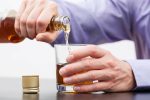In such cases, someone is in danger of choking on their own vomit, leading to asphyxiation and subsequent brain damage.2 Never leave a person alone who you suspect has overdosed on any drug, including alcohol. Alcohol intoxication can vary by tolerance (meaning whether your body is accustomed to the presence of alcohol through repeated use), your gender, body weight, body fat percentage, and other factors. For more information on alcohol use disorder, causes, prevention and treatments, visit the National Institute https://capitaltribunenews.com/top-5-advantages-of-staying-in-a-sober-living-house/ on Alcohol Abuse and Alcoholism. The American College of Cardiology envisions a world where innovation and knowledge optimize cardiovascular care and outcomes. As the professional home for the entire cardiovascular care team, the mission of the College and its 54,000 members is to transform cardiovascular care and to improve heart health. The ACC bestows credentials upon cardiovascular professionals who meet stringent qualifications and leads in the formation of health policy, standards and guidelines.
Recognize Relapse Warning Signs
Middle-aged women are now at the highest risk for binge drinking compared with other populations. Roughly 1 in 5 U.S. adults report binge drinking at least once a week, with an average of seven drinks per binge episode. This is well over the amount of alcohol thought to produce legal intoxication, commonly defined as a blood alcohol concentration over 0.08% – on average, four drinks in two hours for women, five drinks in two hours for men. Alterations to brain structure and function during chronic alcohol use can make it tough for people to stop drinking, despite their best intentions. For instance, the prefrontal cortex – an area involved in planning and decision-making – may become less active, making it harder for people with AUD to make healthy decisions. People with alcohol use disorder (AUD) tend to have thinning in regions of their cortex; the wrinkled outer layer to the brain critical to so many higher order cognitive functions.
Associated Data

The construct of recovery has been difficult to operationalize in the alcohol treatment and recovery literature. The authors present a newly developed National Institute on Alcohol Abuse and Alcoholism (NIAAA) definition of recovery from DSM-5 AUD based on qualitative feedback from key recovery stakeholders Top 5 Advantages of Staying in a Sober Living House (e.g., researchers, clinicians, and recovery specialists). The definition views recovery as both a process of behavioral change and an outcome and incorporates two key components of recovery, namely, remission from DSM-5 AUD and cessation from heavy drinking, a nonabstinent recovery outcome.
Risk Factors for Alcohol Poisoning
However, HHS has set a priority goal of reducing emergency department visits for acute alcohol use, mental health conditions, suicide attempts, and drug overdoses by 10% by 2025. Recovery is a process through which an individual pursues both remission from alcohol use disorder (AUD) and cessation from heavy drinking1. An individual may be considered “recovered” if both remission from AUD and cessation from heavy drinking are achieved and maintained over time. For those experiencing alcohol-related functional impairment2 and other adverse consequences, recovery is often marked by the fulfillment of basic needs, enhancements in social support and spirituality, and improvements in physical and mental health, quality of life, and other dimensions of well-being3.
A timeline follow-back interview conducted at baseline and follow-up assessed drinking practices, income, and expenditures covering the preceding year, which generated detailed behavioral records covering the two years surrounding participants’ drinking resolution date. Recent conceptualizations of the term ‘recovery’ have shifted to emphasize the broader biopsychosocial process of improvement that is related to, but not solely determined by, alcohol consumption. As noted by Ashford and colleagues13, stakeholder institutions, including the American Society of Addiction Medicine (ASAM), have updated and modified their operational definitions of recovery over the past two decades. In 2005, ASAM’s public policy statement on recovery highlighted a state of psychological and physical health in which an individual’s abstinence from substance use was “complete and comfortable”14. Empirical support for a broader conceptualization of recovery has been reviewed in recent work16–18 and also expressed by individuals who self-identify as being in recovery19–21. The moderator of the discussion session, Dr. Edith Sullivan, provided an overall discussion that alcoholism is an enduring, devastating, complex human disease that affects all ages.
- We proposed that CIE-induced loss of D2/D4 function in the PFC negatively impacts a variety of processes in structural, functional and behavioral plasticity.
- Initially, and for sometime afterward, alcohol may seem to enhance certain experiences.
- If you’re in recovery from a substance use disorder, you already know how much work it took to achieve sobriety, and you’ll want to do everything possible to avoid having a relapse.
- The abstinent recovering AD patient group compared to controls showed blunted activation in ventromedial prefrontal cortex (VmPFC) regions to stress imagery, and exaggerated VmPFC activation during relaxed imagery.
Alcohol use disorder has the strongest link to mortality for those with the highest levels of education
This second component includes the same duration qualifiers as component 1, thus providing consistency and standardization across both components. Because there is no amount of drinking without risk, footnotes in Figure 2 are provided to highlight this important caveat, particularly for certain vulnerable populations. The footnote also highlights that physical, mental, and functional well-being are expected to result from the cessation of heavy drinking. From the patient perspective, limited understanding of what constitutes problematic drinking and attitudes towards seeking treatment can hinder recognition of the need for help. For example, among those who meet the criteria for SUD—which may include symptoms like increased tolerance, repeated attempts to quit or control use, or social problems related to use–95% of adults did not seek treatment and didn’t think they needed it. Initiatives aimed at early screening in non-traditional settings, such as schools may help early detection and lead to more timely linkages of individuals to treatment resources.

Component 3: Biopsychosocial Functioning and Quality of Life in Recovery
Perhaps your school performance has declined and you’re in danger of failing or you’ve been missing so many classes because you’ve been hungover that you can’t catch up. Start by talking to your doctor about how much alcohol you’ve been using and your plan to quit. It’s important that you work with your doctor when you’re ready to stop drinking rather than trying to do it alone.
